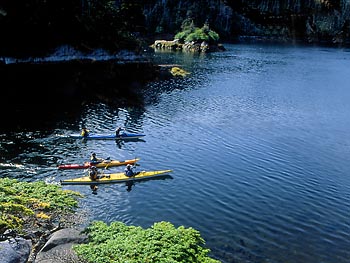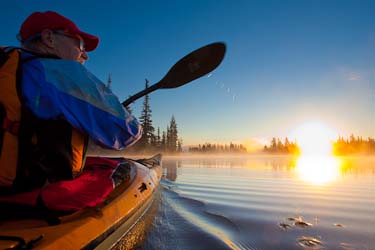
Camera and tripod instinctively pop out when we view a mountain sunset or ocean seascape. The tripod legs spread; we mount the camera, plug in the cable release and fire away. Later we inspect the photo and discover that it doesn’t match our memory. An elementary problem in photography is translating a dynamic 3D world onto flat, static paper or our LCD screen. Pictures are two-dimensional. We may capture brilliant color, the scale, sometimes even the mood, but not the intimacy, the sense of place, the “wow”. We fail to put the viewer in the scene.
So we have a riddle of translation to solve: capturing the feeling that inspired us; making the scene come alive. We need to give the viewer who wasn’t at the scene a satisfying experience. In my 01/07 tip I discussed using a diagonal line to create depth and lead the eye. Another approach is to frame the subject. Put depth and context in your photos with a classic composition technique. To give it a shoutout: “Frame it!”

Creating a frame
To add a frame, use foreground elements top, side or bottom. Surround the subject. A good frame leads the eye as effectively as a diagonal line. The best frames use local objects: the weathered shore pines on the coast, a cactus in the desert, mossy rocks in the rain forest. Animals, people, your tent (especially from the inside looking out) can serve as well. Or on a beach: a kayaker carrying a kayak toward the sea.
Not every photo requires a frame, but here’s a trick: close one eye while surveying the scene to simulate the two-dimensions you’re working to fill. Closing an eye takes away the depth you normally perceive. Oftentimes the prospect fails, and you need to search and find a foreground context, a frame—or move on. Looking through the viewfinder is much like closing an eye, but the shrunk-down scene in the viewfinder doesn’t demonstrate so convincingly the dramatic depth loss as does closing an eye. You could miss it. So if in closing an eye the scene loses its drama, look for a frame to restore it.

If you’re kayaking, framing a shot is best accomplished from shore. Kayaking is paddling shoreline, and while underway the astute photographer is continuously scouting for that overhung, branching tree or undercut rock, or a downed snag that makes a nice leading line. Seek to tell a story.

An even bigger challenge is shooting from the seat of a kayak, but the results can be gratifying. Get the shot by getting low. Take your eye off the viewfinder, with the paddler so close you get splattered from her dripping paddle. Shoot wide, stop down, chop off the stern.
The same principles apply in any situation. If on a hike, step off the trail, or get low as fellow hikers pass by. In all cases done well, the person, tree or cliff-face becomes a revealing window, adding critical context and directing the viewer’s eye into the scene.
Gary